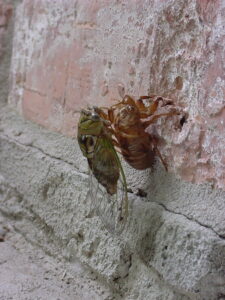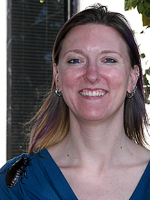
Cicada on it’s discarded exoskeleton
Why Insects Crunch by Wizzie Brown
Insects and other arthropods have an exoskeleton, which means their “bones” are on the outside of their body. The exoskeleton serves as a protective covering, helps prevent desiccation, allows muscles to attach to it from the inside for movement, and provides sensory information.
Four Layers
The exoskeleton is made up of four layers: epicuticle, procuticle, epidermis and basement membrane. The most outer layer, the epicuticle, serves as a barrier to the outside environment and helps the insect avoid desiccation. If you have ever used diatomaceous earth for insect management, you are hoping to abrade the epicuticle of the insect with the diatomaceous earth and cause enough water loss for the insect to die.
The next layer, the procuticle, is for strength. The procuticle is made of chitin, which is secreted by the underlying third layer, the epidermis. The cuticle is soft when it is first secreted, but undergoes a process called sclerotization, which allows for hardening and darkening of the exoskeleton. The procuticle is divided into two components, the exocuticle and endocuticle. The endocuticle is tough, but flexible while the exocuticle is where thickening occurs to provide a more rigid, armored structure. With soft-bodied insects, such as termites, aphids, or caterpillars, the exocuticle layer is greatly reduced.
The epidermis is a layer of living cells that secrete chitin that is used to create the layer above, the procuticle. Any sensory hairs, called setae, that an insect has on its body originate in the epidermis and sensory information travels through the hair on the outside of the insect’s body to nerves found in the epidermis.
The innermost layer is the basement membrane which is a support for the epidermis and a separation from the insect body cavity.
Plate Structure Allows for Movement
All these layers together make up the insect exoskeleton. The exoskeleton is comprised of hardened plates called sclerites. The composition of plate structure allows the insect to have segmented joints and bodies which allows for movement. Each segment has various thickness of sclerites related to the movement and/ or protection required in that given area of the body. Furthermore, the exoskeleton has various areas that are folded inward, called apodemes, allowing for more surface area of the exoskeleton in that particular region and creating a strengthened area where muscles can attach on the inside of the body.
For more information or help with identification, contact Wizzie Brown, Texas A&M AgriLife Extension Service Program Specialist at 512.854.9600.
This work is supported in part by the Crop Protection and Pest Management, Extension Implementation Program [award no. 2021- 70006-35347/project accession no. 1027036] from the United States Department of Agriculture (USDA) National Institute of Food and Agriculture.
Additional Resources
About Wizzie

Wizzie Brown
County Extension Program Specialist – Integrated Pest Management
Email:EBrown@ag.tamu.edu
Wizzie has been with Texas A&M AgriLife Extension Service since 2002 and has been playing with insects since she was a toddler. She is an Extension Program Specialist with the Integrated Pest Management (IPM) program. Wizzie holds a B.S. in entomology from The Ohio State University and a M.S. in entomology from Texas A&M University. The integrated pest management program provides identification, biological and management information to whomever needs help. Wizzie’s research focuses on imported fire ants, including community wide fire ant management. Wizzie also is happy to provide programs to area groups on a variety of arthropod-related topics. You can find insect and other arthropod information on Wizzie’s blog.
